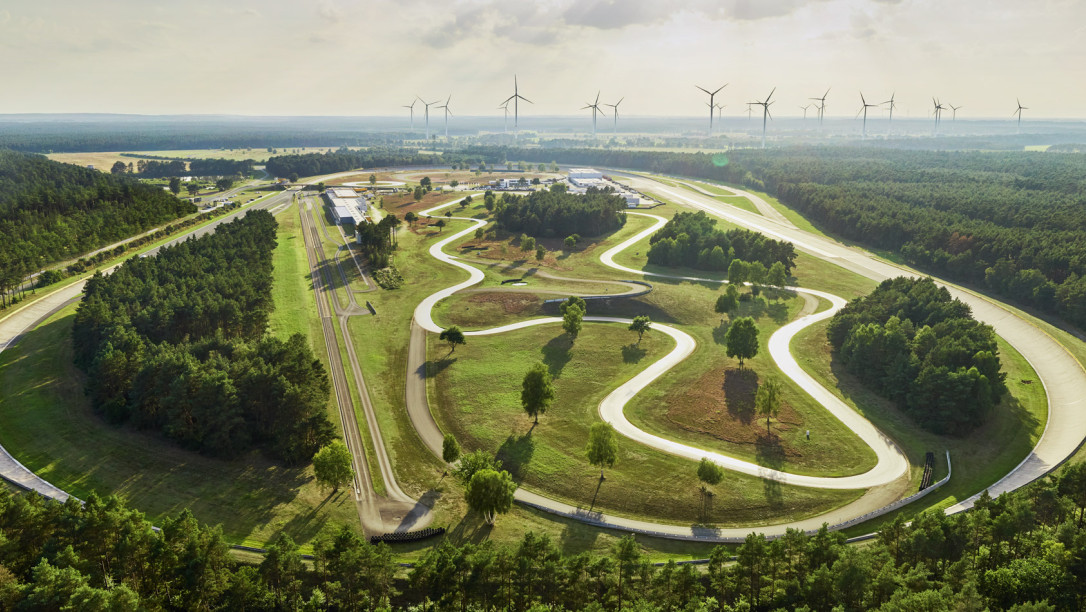
The Home of Automotive Safety. Welcome to the Contidrom.
Dedicated to Driving Performance Our purpose-built test track facility
For more than 50 years, one place has been home to some of the most advanced breakthroughs in tyre technology in the world. The first autonomous vehicle was driven here. Over 1.3 million tyres have been tested on the tracks. A team of over 100, some in white laboratory coats, others in racing helmets, work diligently on microscopic details.
See our Testing in Action

The legendary oval track
Before 1967, no-purpose built testing tracks for tyres existed. Runways and the open road were the only option, but with cars getting faster and the demands on tyres greater, we needed somewhere we could bring more science to tyre testing. That somewhere is just outside of Hannover, where we constructed what is the now legendary oval track. At 2.8kms long and with a 58 degree bank, the oval is built for speed. It’s possible to take the 900 metre long bends at 180 km/h with your hands off the wheel, the steep bank being enough to guide the vehicle around the bend.

The wet handling course
In 1972, we added a wet and small handling track. This allows us to accurately control the amount of surface water, testing the sipes and specific parts of the tread pattern designed to resist aquaplaning. The track is 1.8kms in length and is one of the reasons Continental Tyres enjoy a reputation for being the best in braking.

The large handling track
A more recent addition to the complex, the large handling track was added in 1995 and offers increased testing flexibility. The handling characteristics of tyres can be tested up to speeds of 160 km/h through a series of 7 bends, each designed to exert forces to allow us to better understand how each tyre reacts.

The off-road track
Tyres such as the Continental CrossContact UHP were tested on this track. Comprising steep banks, water basin, muddy gradients and an axial twist track, the off road track is essential in developing a leading range of tyres for today's SUVs and 4 wheel drive vehicles.
The two circle tracks
Two circular tracks of different sizes serve primarily for tire tests in the wet. One circle is mainly used to simulate aquaplaning when cornering, while the other features different road surfaces that can be irrigated by sprinkler systems. In real-world driving, both of these situations represent critical scenarios and therefore need particularly thorough testing during tire development. Another test conducted on a circular track delivers findings on the safety reserves of a tire with a slow puncture: A car or truck circles the track at 55 km/h. In the course of each lap, the pressure in the tires is reduced by 1/10 bar, until the tire literally rolls off the rim.
The Automated Indoor Braking Analyser (AIBA)
This all-weather test facility completes up to 100,000 braking tests a year on dry, wet, and even icy road surfaces. Aided by the extremely precise findings delivered by the AIBA, Continental has been able to make further progress in the development of passenger car, van and 4x4 summer and winter tires. The facility is housed in a hall 300 m long and up to 30 m wide. Inside the hall, a driverless test vehicle is accelerated to speeds of up to 115 km/h fully automatically and then braked to a standstill by a braking robot on various standardized road surfaces that can be exchanged with the aid of hydraulics. It can operate 24 hours a day, fully automated.

From the outset, the test engineers at the Contidrom have defined standards that are applied in Continental’s tire testing activities around the world. The result of all the hard work is no better illustrated than from independent test results. In 863 independent tests conducted since 2010, our products have received the highest rating 715 times - a stunning success rate of 83 percent.

